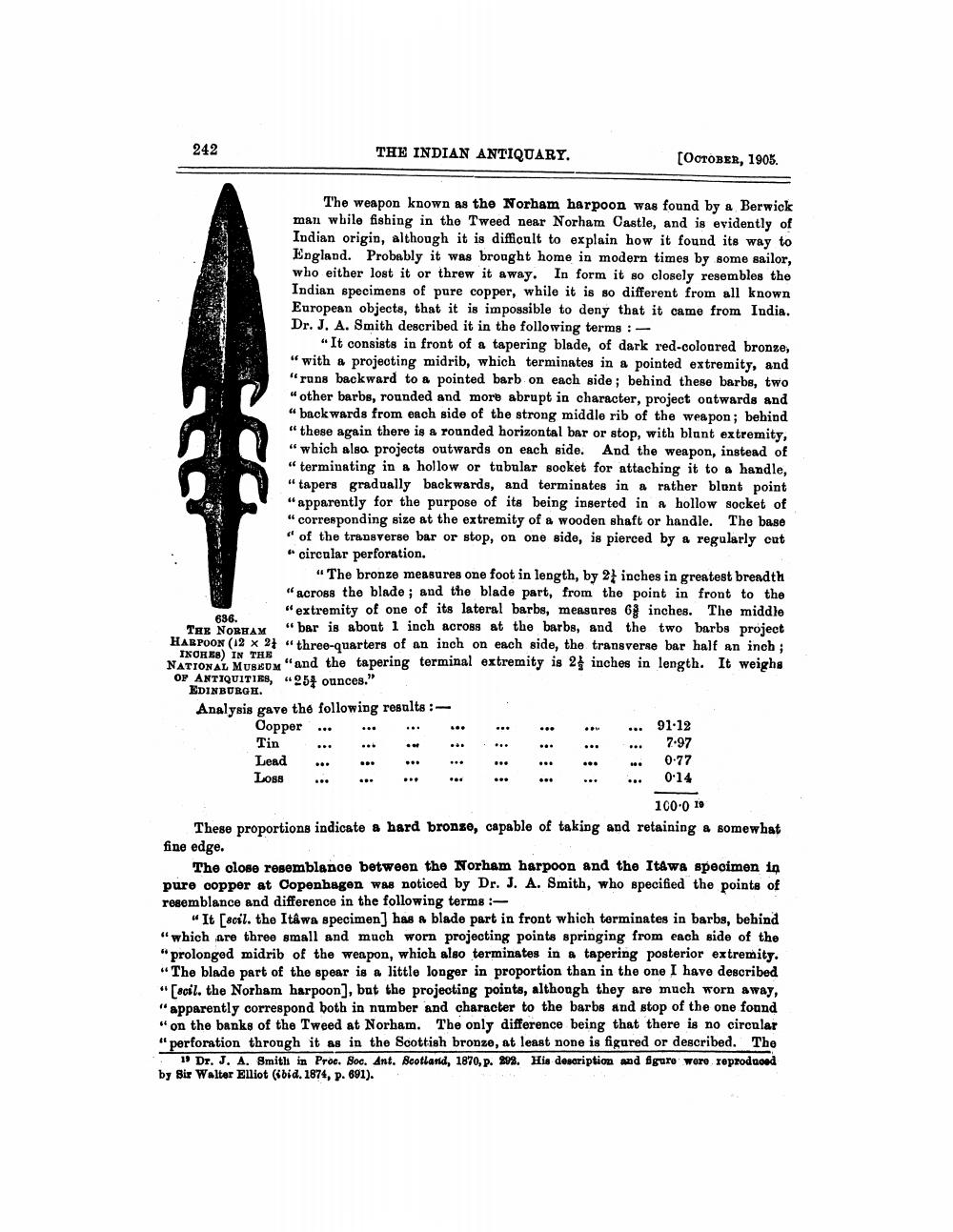________________
242
THE INDIAN ANTIQUARY.
The weapon known as the Norham harpoon was found by a Berwick man while fishing in the Tweed near Norham Castle, and is evidently of Indian origin, although it is difficult to explain how it found its way to England. Probably it was brought home in modern times by some sailor, who either lost it or threw it away. In form it so closely resembles the Indian specimens of pure copper, while it is so different from all known European objects, that it is impossible to deny that it came from India. Dr. J. A. Smith described it in the following terms:
"It consists in front of a tapering blade, of dark red-coloured bronze, "with a projecting midrib, which terminates in a pointed extremity, and "runs backward to a pointed barb on each side; behind these barbs, two "other barbs, rounded and more abrupt in character, project outwards and "backwards from each side of the strong middle rib of the weapon; behind "these again there is a rounded horizontal bar or stop, with blunt extremity, "which also projects outwards on each side. And the weapon, instead of "terminating in a hollow or tubular socket for attaching it to a handle, "tapers gradually backwards, and terminates in a rather blant point "apparently for the purpose of its being inserted in a hollow socket of "corresponding size at the extremity of a wooden shaft or handle. The base "of the transverse bar or stop, on one side, is pierced by a regularly cut "circular perforation.
Tin Lead Loss
"The bronze measures one foot in length, by 24 inches in greatest breadth "across the blade; and the blade part, from the point in front to the "extremity of one of its lateral barbs, measures 68 inches. The middle "bar is about 1 inch across at the barbs, and the two barbs project HARPOON (12 x 2 "three-quarters of an inch on each side, the transverse bar half an inch;
636.
THE NORHAM
IN THE
NATIONAL MUSEUM "and the tapering terminal extremity is 2
inches in length. It weighs
OF ANTIQUITIES, 25 ounces." EDINBURGH.
Analysis gave the following results:
Copper
[OCTOBER, 1905.
...
..
91.12
7.97
0.77 0:14
100-0 10
These proportions indicate a hard bronze, capable of taking and retaining a somewhat fine edge.
The close resemblance between the Norham harpoon and the Itawa specimen in pure copper at Copenhagen was noticed by Dr. J. A. Smith, who specified the points of resemblance and difference in the following terms :
"It [scil. the Itâwa specimen] has a blade part in front which terminates in barbs, behind "which are three small and much worn projecting points springing from each side of the "prolonged midrib of the weapon, which also terminates in a tapering posterior extremity. "The blade part of the spear is a little longer in proportion than in the one I have described "[scil. the Norham harpoon], but the projecting points, although they are much worn away, "apparently correspond both in number and character to the barbs and stop of the one found "on the banks of the Tweed at Norham. The only difference being that there is no circular "perforation through it as in the Scottish bronze, at least none is figured or described. The
19 Dr. J. A. Smith in Proc. Soc. Ant. Scotland, 1870, p. 292. His description and figure were reproduced by Sir Walter Elliot (ibid. 1874, p. 691).




